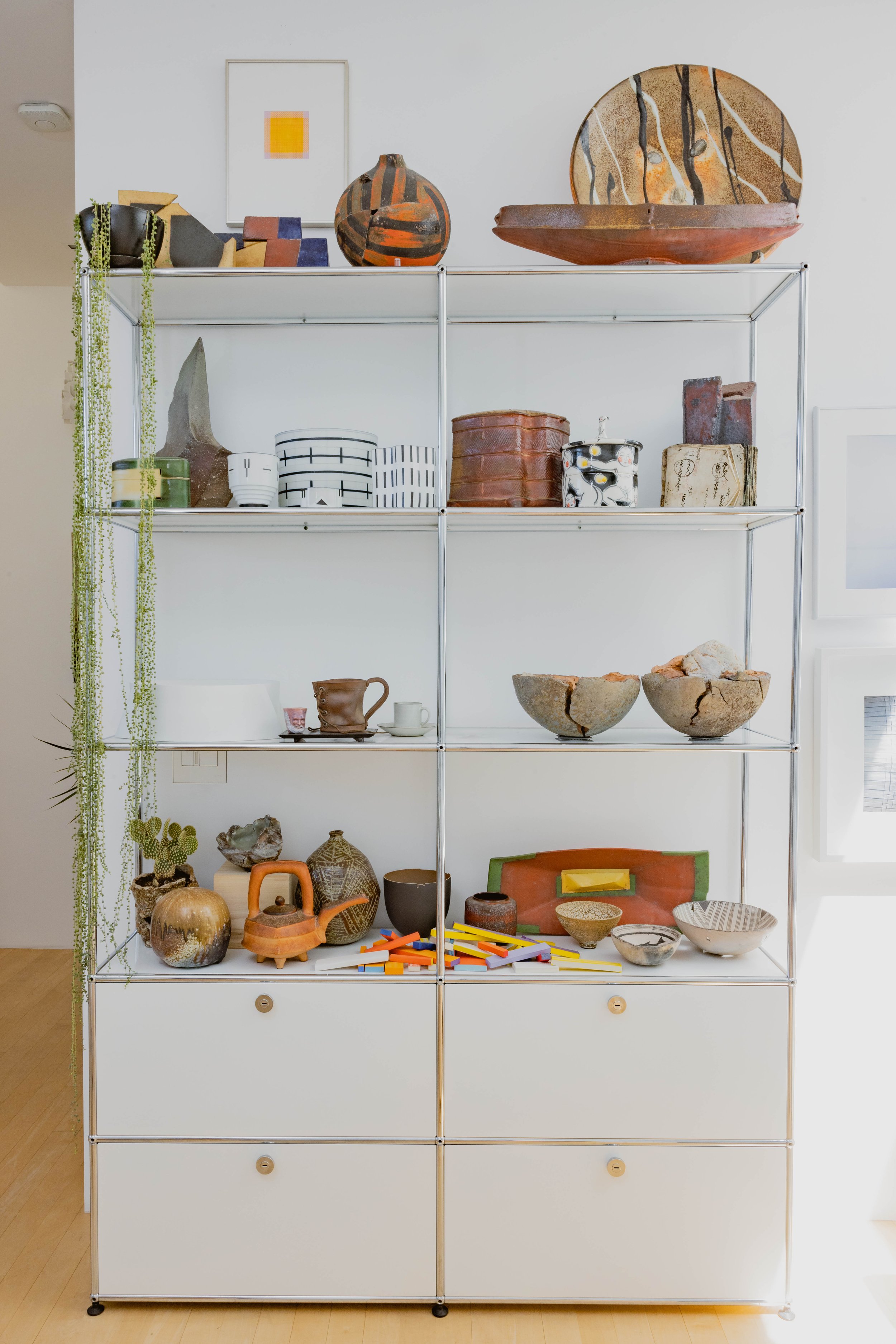WITH JEFFREY SPAHN GALLERY
BEHIND THE SCENES WITH JEFFREY SPAHN GALLERY
Jeffrey Spahn Gallery, a specialist in ceramic art and 20th century sculpture with a focus on American, British, and Japanese studio ceramics. His Berkeley-based gallery holds one of the largest inventories of consigned pottery and ceramic sculpture by artists such as Robert Arneson, Ruth Asawa, Hans Coper, Shoji Hamada, Gertrud and Otto Natzler, Isamu Noguchi, Lucie Rie, and Peter Voulkos. With over 20 years experience in the field, Jeffrey has worked with some of the premiere museums, universities, public and private collections in the world.
Our team visited his Berkeley gallery, where we marveled over his vast collection and learned more about his life and work.
Q: What was your first experience that piqued your interest in 20th century sculpture in studio ceramics? What impact did this experience have on you?
I grew up near Buffalo, New York. Believe it or not, there's a phenomenal contemporary art museum there called Albright-Knox Art Gallery. My family happened to know the Knox family, they were the owners of a very important store called Woolworths. So we had special access to the museum, even when I was a little boy. One of my favorite sculptures was a Joseph Cornell that hung on the wall and was this little diorama box that had little floating ceramic ball inside that looked like the moon. I loved all those contemporary masters of 20th century sculpture and they’re still all of my favorites. We would drive to our summer cottage in Canada and on the way there we would go through New York. There was a very important art museum there and it's still one of the most famous ceramic art museums. We would stop there to have lunch and I fell in love with this big bowl, this big ceramic bowl by an artist named Glen Lukens; it looked like the glaze was melted cheese. As a 7 or 8-year old, I would just stare at it and was mesmerized by it was this big bowl and my mom would have to pry me away from the glass case. I've been obsessed with ceramics since I was a little kid — since I was 7 or 8.
Q: What is one thing you wish more people appreciated about 20th century sculpture and studio ceramics?
Today, people actually are appreciating ceramics as part of 20th century sculpture — that's exciting for me because I've been doing this for 20 years. 20 years ago, ceramics was considered craft. But today, because people like Christine Lin and a younger generation of interior designers and art advisors have fresh eyes; they see things like fiber arts and glass, furniture, and photography… whole diversity of art forms, including fashion and all kinds of creative pursuits as legitimate art forms. Quite frankly, ceramics is one of the art forms that's been the most legitimized - artists like Louise Nelson, Helen Frankenthaler, Robert Rauschenberg and many, many more. So when you realize that many of the most famous painters have also worked in clay, ceramics has sort of been one of the most legitimate art forms. You can always add interesting objects or interesting design pieces of sculpture to a room because they change the space. Christine [Lin] knows better than anybody because she's an architect.
Q: If there was an earthquake and you could only grab one ceramic piece to save, which would it be and why?
If there's one piece that I really identify with, it's one made by a British artist named Hans Coper. It's a very minimalist, simple monolithic black form and has these almost imperceptible textures of the clay. It was designed very, very thoughtfully and most people think it's a candlestick but it's a flower vase. It’s worth $300,000 now and most people think I'm crazy that I still use it for flowers, but I use it all the time because it was meant to be used. It wasn't meant to be just admired. Of course, you can just admire it, it's beautiful on its own. But when it's in use, it's even more beautiful, because it's so minimalist and so unobtrusive. It's very, very quiet. When you add flowers to it, it becomes sort of the backdrop to a much bigger affair.
Q: How has the pandemic impacted your business, if at all? Are there any pivotal moments or lessons you can share from this two year period?
We've been really lucky because my business was structured as an online company almost 20 years ago. 20 years ago, people thought it was crazy to sell art through email and people thought it was blasphemous to open up a gallery that didn't show art that people could see and touch with their hands. — I thought it would work if the art is themed enough. Now every single gallery that has a physical space also sells through a website, there's not a single business I know that isn't also online. But we started out that way, so it didn't affect us, thankfully.
The only thing that changed for me personally is that I often traveled and went out to see collections. I often went out and traveled because people would ask me to lecture and to present contemporary ceramic, resale art or estate planning, and collection management — but that changed during the pandemic. Instead, I was asked to do lectures on Zoom or virtual tours of my house and collection.
One thing that did happen that I would like to touch on is the Black Lives Matter movement. I used to teach multicultural education at UC Berkeley, a lot of galleries and businesses put out statements about Black Lives Matter. Many businesses asked me to review their statements and to asked for my opinion on if their statement was multiculturally sensitive enough — I found that very interesting, that whole time period, and how people, some people chose to step up and respond to that moment, and some people didn't. But I found it very interesting that as a minority, a lot of people turned to me, and I’m sure this happened to many other people, asked our opinion as to what was okay and my challenge to the majority folks was to say to them that this is your moment.
I found it very interesting how the Black Lives Matter movement changed the way majority of online businesses became more (what I would call) self-conscious or more aware of their position in society. I'm not convinced that everybody made positive change from that. But I did see a lot of change come from that even though some of it seems forced to me, I still think that even sometimes you have to force change and forcing change is better than no change at all right. I'm seeing it ripple down into not just for the Black community, but I'm seeing more representation in the arts for women artists, AAPI artists, LGBTQ+ artists, and other marginalized communities. So that was a big, big thing that happened during the pandemic.
Q: You shared in a 2018 interview with Art Net that ceramics have often been a marginalized genre of the fine arts world, as it is typically underrepresented in major museums and galleries from your vantage point. Have you seen In a positive shift for ceramics in the last four years?
The technology is changing all the time. We just put an artist named Ron Rael in Smithsonian American Art Collection and he's the chair of the architecture program at UC Berkeley. He is very active in the Latinx movement and a 3D printing ceramics expert. He is also working on 3D printed concrete housing to address affordable housing issues. He uses 3D printed ceramics as a way of working out forms and issues as it relates to affordable housing. But we got his ceramics into the Smithsonian American Art collection. It’s kind of exciting to collect on that level because you can help affect change by supporting what experts are working on and how they’re addressing issues like that today. Ceramics can be a part of a bigger picture, you know?
I sell the masters of 20th and 21st century ceramics, right. But in addition to that, there's a whole new burgeoning sector of contemporary makers that we don't necessarily sell, but that I would encourage people to keep their eyes and ears open to people, like Christine, who are constantly looking at art fairs and markets, to those who are open to new artists that I don't even know about. I'm often looking at the change makers that are in the museums and have established careers. When somebody's building a collection, I think it's important that they have some icons in their collection, because having even one or two major figures can really anchor a collection. I also think you should be looking at what's new and out there, because you should buy what you like, and nobody knows what's going to end up being the thing that is going to be THE iconic work 40 years from now. In the fine art world, I think people like Christine are even more aware, because she's seeing a much wider range of options for clients than we even see for for the new young makers.










